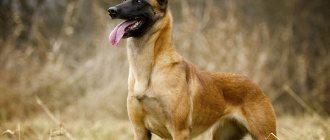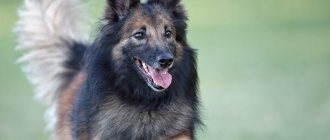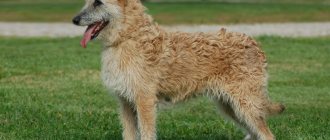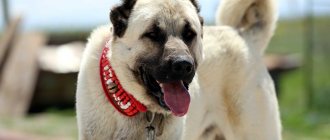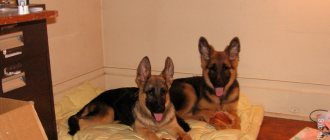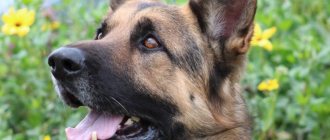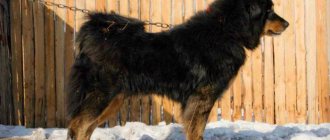The Belgian Shepherd is a dog that is popular all over the world. One of the varieties is the Malinois. This is an elegant, strong and hardy dog that is in demand in the police, security, Ministry of Emergency Situations, and the army. Thanks to their high intelligence and independence, these dogs help search for prohibited substances and missing people. They are loyal, affectionate, but suspicious and vigilant guards. Parenting needs to be taken seriously; not everyone can handle it. Therefore, before getting this breed, you need to study the features, pros and cons, as well as reviews from the owners.
- Varieties
- Head and muzzle
- Training and education of Malinois
- How to feed a Malinois
Description of the Belgian Shepherd breed
Popularity 165th place among 263 dog breeds
Lifespan:
10-14 years
Breed group:
Shepherd's
Height:
males: 60-66 cm, females: 56-62 cm
Country of origin:
Belgium
Average price:
40-60 thousand rubles
Weight:
males: 25-30 kg, females: 20-25 kg
Latest articles Cat health
Rabies vaccination for cats: choice of vaccine, necessity, schedule 01/22/2022 4 0 0
Selection and adaptation
TOP 20 best cat breeds for families with children 01/22/2022 25 0 0
Groenendael
The division of Belgian Shepherds into varieties is based on the type of coat and its color.
Photo 1. Belgian Shepherd - Groenendael
If the “Belgian” has long black (and only black!) hair, we have a Groenendael .
The name of the breed variety is inherited from the name of the Belgian town of the same name, where the breed was bred by local dog breeder Nicholas Rose.
In the United States, it is the Groenendael—unlike all other varieties—that personifies the Belgian Shepherd breed.
Key facts
Indefatigable energy, thirst for knowledge, love of freedom are the main characteristics of the Belgian Shepherd breed. The dog's inherent friendliness makes it an excellent companion on long hikes, on a morning jog or just a walk in the park. The dog's well-developed guarding qualities, inherited from its ancestors, allow it to be used as a watchman.
It’s not for nothing that another name for the breed sounds like “shepherd dog,” but the name given to it after its country of origin is known all over the world – Belgian Shepherd Dog.
It will not be easy for dog breeders who have insufficient experience in raising four-legged dogs with a Belgian Shepherd. Only a strong personality can tame this wayward creature. The description of the Belgian Shepherd breed emphasizes this fact. Early socialization, as well as the patience and perseverance of the owner, will make the dog a faithful friend for life.
Shepherds are quite large animals. The weight of females reaches 20-25 kg, and males - up to 25-30 kg. The height of Belgian Shepherd females is 56-62 cm, in males the height at the withers is 60-66 cm.
The health of Belgians, like any herding breed, is not bad, but only if they are well cared for. The lifespan of the Belgian Shepherd is average and can range from 12-14 years.
Nurseries
In Russia, the breed is just gaining popularity, but Belgian Shepherd kennels are already operating in large cities. Purebred puppies can be purchased from:
- Moscow - “Line of Grace” https://liofgr.ucoz.ru, “From Solnik” https://www.solnik.ru;
- St. Petersburg - “Pearl of the North” https://hochusobaku.ru/kennel/3749/.
Belgians are loyal and hardy animals, very devoted to their owner. However, a dog will show positive qualities only with proper upbringing. She needs a self-confident leader - if you give him slack, the pet will grow up eccentric and uncontrollable.
History of the origin of the Belgian Shepherd
It can be considered that the origin of the shepherd breed goes back to ancient times. Indeed, the first mention of dogs resembling the Belgians appeared in 1650. But breed researchers believe that shepherd dogs like these have been around for no more than 100 years.
This fact is explained by the fact that in the 17th century or somewhat later there were no breeders willing to develop and improve the breed. This explains the unpopularity of shepherd dogs among aristocrats. The main owners of animals were peasants, who were concerned about the working qualities, and not the appearance of the animals.
This development of events led to the appearance in the 19th century of a wide variety of colors among the Belgians, but the watchdog qualities remained at their best. They knew how to herd the flock, protect it, and prevented the sheep from scattering in different directions. Belgian farmers fell in love with dogs for their high intelligence and speed of reaction.
With the onset of industrialization, the need for the working qualities of the herding sheepdog began to decrease in the territory of the country of origin. Only a wave of ardent nationalism gave impetus to further development and improvement of the breed.
Then the idea arose of creating a nationally significant breed that would be different from shepherd dogs from other countries. Thus, in September 1891, the world's first Club of Belgian Shepherd Lovers appeared in Brussels. A couple of months later, over a hundred animals of this breed were presented at an exhibition in Kurgam.
Professor Adolf Riyul decided to go even further. He wanted each region of Belgium to have its own shepherd, different from the others. For work, he selected medium-sized individuals, without paying attention to the color and length of the coat. In 1892, the first breed standard was presented to the world. Further improvement lasted another twenty years.
It led to the identification of four categories of shepherd dogs:
- Groenendael - animals with medium-length black fur;
- Laekenois - ash-gray long-haired dogs;
- Malinois - short-haired individuals of brown-yellow or charcoal color;
- Tervuren are shepherd dogs with a long coat of charcoal-red hue.
Not all breeders recognize these varieties as one breed, but officially all representatives of shepherd dogs, no matter how different they may be, are classified as Belgian.
Official confirmation of the standards came in 1901, when, after painstaking work by breeders, the Royal Society of St. Hubert included the shepherd dog from Belgium in the register of breeds. For each line, separate characteristics were created, taking into account color and hair length.
A few years later, the four-legged animals joined the national police and began to be used to catch bandits and smugglers. These brave animals were highly appreciated by police from the USA and France. Gradually, the fame of the Belgians spread throughout the world. However, the Grunandel and Malinois are still considered the most popular.
Application
The Belgian Malinois is a hardy, strong animal. Adapted to various weather conditions, it is not afraid of rain, heat or cold.
The Malinois is considered the most adapted to harsh conditions compared to other Belgians. After all, dogs were originally bred to help herd and guard livestock. Over time, these qualities improved, and the most productive individuals were selected for further breeding. Such qualities as resistance to stress, sociability, and gentleness were valued.
Modern Belgian Malinois dogs are divided into two groups: working dogs and ring participants. Working dogs are used in the service of law enforcement agencies. Their help in searching for missing people, in police service, and security is invaluable. Ring dogs are also hard workers, but in a different direction. Participation in sports competitions and exhibition shows fully demonstrates the dog’s capabilities.
Appearance of the Belgian Shepherd
General impression
The Belgian Shepherd is a large breed of dog. Her strong build and steely muscles make her look menacing. This is also facilitated by the ferocious grin of sharp teeth. In the photo, the Belgian Shepherd looks menacing, but its temperament is softer than it seems.
Head
The animal's head is folded dry and harmonious. It is somewhat elongated and high-waisted. The flat frontal part is not clearly expressed along the midline. If you look at the profile of a shepherd dog, two parallel lines of the muzzle and forehead are clearly visible. The cheekbones have well-developed muscles, but are not very defined. The brow ridges protrude slightly from the forehead line.
The rather long muzzle of the individual has a narrowing at the end. The nose is black with wide open nostrils. The oral mucosa is also dark in color without pink areas. The lips are thin, pressed tightly to the jaw.
The triangular-shaped ears are pointed at the tips, and, on the contrary, are smoothly rounded at the base. When alert, the ears are positioned straight and vertical.
The shepherd's teeth are strong and white. The bite of the strong jaws is scissor-shaped.
Neck
The fairly long and straight neck has a high set, without a characteristic dewlap, with a smooth, slightly curved scruff. It is slightly widened towards the shoulder blades.
Torso
The dog's body is massive, but does not look heavy due to its almost ideal proportions. In males, the length of the body is equal to the height, while in females the length is slightly longer. The voluminous chest is quite wide, the ribs have a smooth curve. The clearly visible withers merge into a straight topline. The pet's croup is suspended with a slight slope, the abdominal line is well tucked. Rendered muscles are visible throughout the body.
Forelegs
The front legs have strong bones and muscles. A wide angle is formed when the elongated shoulder blades meet the shoulders. Short pasterns with rounded paws turn into tightly clenched fingers with strong, dark-colored claws.
Hind limbs
The hind legs stand perpendicular to the ground and are characterized by strong muscles on the broad thighs and lower legs. The hock joints are fairly arched. The oval-shaped paws have durable pads.
Tail
The tail is of medium length and appears wide at the base. At rest it is lowered, and when in motion it is raised, without forming a curl or curvature.
Movement
The shepherd is very active. While running, due to her temperament, she cannot move in a straight direction for long; she needs a lot of space. More often the dog uses a trot or a relatively calm walk, but sometimes it moves at a gallop. Her movements are sharp and springy.
Wool
The pet's coat is quite dense with a thick undercoat. But each of the four varieties of shepherd dog has its own distinct characteristics:
- Groenendael has a long, smooth coat without a glossy sheen;
- Laekenois has coarse, rough-to-the-touch, tousled hair;
- Malinois is a representative of the shepherd dog with short hair;
- The Tervuren is similar in type to the Groenendael, but the face has characteristic eyebrows, a beard and mustache.
Regardless of coat length, Belgian dogs require careful grooming.
Color
The colors of the Belgian Shepherd differ from each other along each line. So, Groenendaels are black dogs with white spots on the toes or chest. The Laekenois is a reddish hue with white markings and a darker muzzle and tail. The Malinois is an interesting tan color with black ears and muzzle. The Tervuren's coat is similar in color to the Malinois, but the chest and fingers are colored white.
Size
The Belgian Shepherd is quite large in size, but it looks neat and very proportional. The height of females at the withers reaches 56-61 cm, and males - up to 61-66 cm. The weight of the Belgian Shepherd ranges from 20 to 30 kg, depending on gender.
How much do Malinois puppies cost?
To purchase a puppy with a good pedigree, you should contact a nursery. The price for working dog puppies will range from 35 to 50 thousand rubles. For puppies intended for show shows, the price can reach 60 thousand rubles.
Sometimes puppies appear in nurseries with traces of defects, due to which the dog cannot participate in exhibitions and breeding in the future. Such puppies are given away almost for nothing. If you need a dog to guard your home, or just as a friend, without plans for a show future, then you can take it without a pedigree.
Nurseries
Malinois (Belgian Shepherd) is the most popular dog for service in the police and army, in disaster medicine units. Thanks to its high sense of smell, it is the best assistant in searching for people and detecting narcotic and illegal substances. A dog whose life without work is impossible. Malinois puppies purchased from professional nurseries have every chance of becoming ring champions.
Vyatkina nursery https://working-malinois.com/
Service dog nursery https://www.freiwind.ru/index.html
Faithful, selflessly devoted, ready to come to the rescue at any moment, and at the same time affectionate dog - the most suitable description of the Malinois breed. This is an ideal companion dog for sporty and socially-loving people.
Personality of the Belgian Shepherd
Each of the four varieties of the Belgian Shepherd has character traits unique to it. Moreover, an inexperienced dog breeder will not be able to understand this right away. Only when comparing shepherds is it easy to see their differences in behavior or attitude towards the environment.
The Groenendael is best suited for the role of a security guard. These animals are very attentive and have well-developed intuition. In case of danger, the dog will notify everyone by barking loudly. She will not be afraid of a stranger, but will be very wary of him in the presence of family members.
The character of the Belgian Shepherd Laekenois combines playful and serious qualities, the desire to move mountains and jump into the owner’s arms. For the sake of protecting the owner or members of his family, the Belgian is ready to tear to pieces the enemy. The direction of Laekenois behavior will depend on the goal set by the person. She can become an excellent guard or a wonderful companion.
The Malinois is a balanced individual, capable of following on the heels of its beloved owner. She understands human intonations well. This variety of Belgians needs constant attention from humans and suffers greatly when it is lacking.
Tervuren is known for its lively, temperamental character. He is ready to immediately enter the game and give chase. Chewed slippers or broken pots will be the result of loneliness, which the Tervuren will not be able to calmly endure.
Considering the characteristics of each branch of the Belgian Shepherd, breeders call their common traits:
- autonomy, independence in decision making;
- increased sensitivity to yelling or criticism;
- good adaptation to new living conditions;
- desire to dominate other animals.
The owner of the Belgian should show maximum love and patience so that the pet can show the best traits inherent in its type.
Characteristics of the Malinois
The Belgian Malinois is an obedient and devoted pet. He needs a strict but loving owner who will pay a lot of attention. This breed is not suitable for busy or lazy people. To avoid problems, you need to study your character traits.
The dog will constantly follow the owner, try to please him, participate in all his activities and poke his nose everywhere. He should feel like a full member of the family. These dogs are ready to serve their owner all day long and protect him. Fans of the breed note their ability to predict a person’s desires, read thoughts and determine mood.
With proper upbringing, these are the most obedient and flexible representatives of Belgian Shepherds. Only a Malinois can turn around in a jump in the air at the command “fu”. They are affectionate, loyal, devoted, friendly. They get along well with all family members, including teenagers.
For a Malinois to have a good relationship with a small child, they must grow up together. These dogs are balanced, reserved and patient. They are used to herding sheep, and they treat children the same way. But they do not like disrespectful treatment; they will not tolerate having their tail or ears pulled or their toys being taken away. Therefore, small children should not be left unattended with a pet. But with proper upbringing of the dog and teaching the child the rules of behavior with a dog, it will become his best friend.
The Malinois also has the following qualities:
- observation;
- intelligence;
- independence;
- cheerfulness;
- ability to make decisions independently;
- sensitivity, ability to empathize;
- loyalty to a person;
- equilibrium;
- courage;
- the desire to dominate other animals.
The Malinois is not a calm pet. He will not lie on the couch; on the contrary, he is always looking for something to do. He needs at least 3 hours a day of active physical activity to expend accumulated energy. Otherwise he will throw it out at home. These pets are very active and playful, especially in puppyhood, that is, up to about 5 years.
Malinois are not aggressive, but they are wary of strangers. They have a highly developed instinct to protect their territory. Noticing a threat, the dog will fearlessly rush to defense. But it will never pursue a stranger or act contrary to the owner’s command. You should not have a Malinois as a watchdog. These dogs cannot live without work and intellectual activities. Without communication with the owner and stress, they are unhappy and can become aggressive, nervous and stubborn.
The photo shows the behavioral features and habits of these shepherds:
Malinois and Frisbee
Malinois in training
Malinois with a child
Malinois jump
Training and education of Malinois
This dog needs serious training, early socialization and constant attention from the owner. She is intelligent, very smart, has a good memory, but not everyone can cope with training. Therefore, you should not get this breed if you have no experience in raising a dog or time for a dog. The Malinois can easily be trained by an experienced owner thanks to the following qualities:
- performance;
- endurance;
- sharp mind;
- observation;
- lightning-fast reaction;
- good memory;
- stress resistance.
It is necessary to start training a Malinois from early childhood; in adulthood it will be impossible to re-educate him. Basic training should last up to 7 months, during which time stereotypes of behavior and habits are formed that remain with the pet for life.
After adapting to the new home, the puppy needs to begin to be introduced to the outside world. You need to learn to react normally to passing cars and strangers, not to rush at birds on the street, and not to be afraid of sharp sounds. Training with your baby should be done in a playful way, it should be interesting and not very tiring at first.
The owner must behave calmly, confidently, and not raise his voice. Rough treatment of the pet, aggression or physical impact is unacceptable. Malinois understand intonations and guess a person’s mood. If you gain the dog’s trust and become its friend, it will copy its owner’s behavior and become just as balanced.
You need to work with your pet for at least 2 hours a day. These dogs enjoy training. They are able to remember more than a hundred commands and easily learn various tricks. It is important that the training is not monotonous, otherwise your pet will get bored with it. It is recommended to constantly make the lessons more difficult. You can teach Malinois freestyle, agility, frisbee.
The video will complement the description of the characteristics of the breed:
Video: Top IMPORTANT facts about Malinois that you need to know. A dog is not for everyone!
Video: Belgian Shepherd Malinois. Experts talk about the breed
Education and training
The Belgian needs a long, thorough socialization. You should start raising and training a Belgian Shepherd immediately after the puppy appears in the house. Here it is important to take into account the psychology of the pet and understand its character. This will not be easy for an inexperienced amateur dog breeder to do.
According to owners' reviews, females are more docile, while males behave worse in training. In any case, by the beginning of basic training, the shepherd dog must:
- recognize the owner's voice the first time;
- observe the rules of hygiene;
- be able to go for walks on a leash;
- respond to your nickname.
The training exercises themselves are selected taking into account the type of shepherd dog. So, Groenendael needs to be given a clear task. The individual will perceive the learning process itself as a game, so commands are executed with pleasure, without any delay. The dog thinks of training as fun, but with benefit.
Laekenois will take on his master's tasks with great joy, and because of his tirelessness, he will complete everything quickly. To prevent your pet from getting bored, commands must be changed frequently. It should be noted that it is from the Laekenois that it is possible to raise a rescue dog, a security guard or a brave police shepherd dog.
Malinois training must be alternated with work on the site with young animals. This will make it easier for your pet to get used to interacting with other animals. Early training will help this highly intelligent shepherd to fully master the entire training system.
Independence, as well as the desire to dominate, is manifested to a greater extent in the Tervuren than in other representatives of the breed. Dogs need to undergo very intensive training to develop obedience. You should not show dissatisfaction: only patience, calmness, and a fair attitude will help in raising a Tervuren.
For any of the four varieties of Belgian Shepherd, alternating individual lessons with group exercises is important. Only in this way can the animal get used to communicating with other individuals and learn to behave correctly in a crowd of dogs.
Looking for a Belgian Shepherd? Find your pet from 7 offers Buy as a gift
Breed traits
Breed traits (on a 5-point scale)
| Belgian Malinois | |||
| Activity | in the house | 3.6 | |
| on the street | 4.8 | ||
| Obedience | training | 4.8 | |
| strangers | 4.6 | ||
| Domination | in family | 3.2 | |
| over dogs | 3.6 | ||
| Defending your territory | from people | 3.4 | |
| from dogs | 4.2 | ||
| Sociability | in family | 5 | |
| with strangers | 3.4 | ||
| with dogs | 3.2 | ||
| Concentration | in family | 1 | |
| in front of strangers | 2.2 | ||
| with dogs | 2 | ||
| Aggressiveness | in family | 1 | |
| to strangers | 2.2 | ||
| to the dogs | 2.6 | ||
| to cats | 3.4 | ||
| Family behavior | calmness | 4.8 | |
| demand for affection | 4.6 | ||
| excitability | 4.4 | ||
| playfulness | 4.4 | ||
| excessive barking | 2.6 | ||
| behavioral breakdowns | 2.2 | ||
| Tolerance for children | up to 4 years | 4 | |
| over 4 years old | 4 | ||
| Institutional use | watchman | 4.6 | |
| bodyguard | 2.4 | ||
This breed is often compared to the following dog breeds: German Shepherd, Doberman Pinscher, Border Collie, Labrador Retriever, Rottweiler.
The photo shows what representatives of the Malinois dog breed look like:
Belgian Shepherd Health and Diseases
Possible diseases
Belgians are considered to be a breed with strong immunity. However, owners should not forget to monitor the pet’s health: it is necessary to carry out routine and preventive vaccinations, and regularly take the dog for examination to a veterinarian. There are problems that all happy owners of four-legged friends face. First of all, we should mention infectious inflammation of the eyes, conjunctivitis. Common ones include ear infections, dislocations, food allergies and dermatitis.
However, there are a number of specific diseases that Belgian Shepherds suffer from more often than other breeds:
- lack of hormones produced by the thyroid gland;
- cramps, bloating, flatulence;
- joint dysplasia;
- hereditary epilepsy;
- cataract of the eye.
Due to an incorrect or poorly balanced diet, shepherds can become obese due to overeating.
Reproductive health
Puberty in females occurs by the age of one and a half years. Then the female's third heat should begin. Mating is carried out on the 10-15th day of estrus. It is not recommended to do this before, because the animal is unlikely to be able to bear and give birth to healthy offspring. Mating is carried out on the territory of the male dog to create more comfortable conditions.
It is advisable to carry out sterilization before the puppy is one year old, so that the operation takes place with fewer health consequences.
Health
Belgian Shepherds have good health - with proper care and good heredity, dogs rarely have problems. Many representatives of the breed live to old age, maintaining a sharp mind and high physical activity. On average, a pet of this breed lives 10-12 years.
The recorded record of longevity among Belgians is 18 years and 3 months.
Diseases
Belgian Shepherds, like all large dogs, have joint problems. Animals older than one year must be photographed to determine the extent of the disease.
Belgians are also more likely than other breeds to suffer from the following ailments:
- epilepsy;
- Aujeszky's disease;
- retinal atrophy;
- cataract;
- gastric volvulus;
- cancer.
Dogs also have problems with the thyroid gland, hemophilia, osteochondrosis, and infertility. Belgian Laekenois are most susceptible to these diseases, since during selection, breeders crossed closely related individuals.
To protect your Belgian Shepherd from diseases, you need to provide it with proper care and a balanced diet, regularly show it to the veterinarian, and carry out routine vaccinations.
Vaccinations
Puppies are kept breastfed for up to 8 weeks. At this time, passive immunity is formed in animals, which protects the dog from diseases. When the amount of antibodies in the blood decreases, pets are vaccinated against:
- rabies;
- infectious hepatitis;
- parainfluenza;
- leptospirosis;
- carnivore plague;
- herpesvirus.
At 6 months, Belgian Shepherds are given a second rabies injection.
In the future, dogs are annually given vaccines against these diseases. Also, once every 3 months, pets are treated for parasites.
Features of feeding and diet
The Belgian Shepherd's diet must be varied and balanced. Only in this case is the correct and complete development of the pet possible. The basis of the menu should be protein foods. Do not forget about introducing carbohydrates and fats into the diet, which are necessary to keep your pet in an alert state.
What food to use is decided by the owner himself. The pet reacts normally to both natural food and dry industrial food. However, the latter can cause digestive problems, so the food must be of high quality: premium or holistic. The advantage of good feed is its balance. They already contain all the necessary vitamin and mineral complexes.
Natural food must be chosen correctly; more than half of the menu should consist of low-fat meat products: rabbit, chicken, beef or lamb. When added to food, vegetables and fruits should be boiled and chopped. Among the cereals, preference is given to buckwheat, rice, and oatmeal.
You should not give your shepherd:
- chocolate or sweets;
- flour;
- tubular bones;
- river fish;
- legumes
It is important to ensure your dog has constant access to clean drinking water for any type of diet. The purity of the water is checked 2-3 times a day.
From the age of one month, puppies begin to be fed. For this purpose, low-calorie fermented milk products are used: cottage cheese, boiled chicken egg yolks, liquid porridge.
You cannot overfeed Belgians or treat them with food from the master's table. This can lead to the development of obesity and food allergies.
Mating
It is illegal to mate two varieties of Belgians, such as Groenendaels and Malinois. Exceptions are made only in extraordinary circumstances. The decision to lift the restriction is made by the authorized canine council.
Fully formed individuals who are at least 1.5 years old are allowed before crossing. The dogs are first introduced on neutral territory, after which the bitch is brought to the male. In a familiar environment, the male acts confidently and actively. The optimal time for mating is 11-15 days of estrus.
A month before mating, animals are wormed and treated for fleas and ticks.
Belgians are usually bred freestyle, but young animals may require assistance from their owners. Inexperienced dog breeders are better off inviting a professional breeder who can supervise the process. 24 hours after mating, a control mating is carried out - then the probability of a favorable outcome will increase significantly.
The Belgian pregnancy lasts from 56 to 72 days. At this time the bitch:
- protect from stress and drafts;
- provide balanced nutrition and vitamins;
- do not overload physically;
- Take him to the vet regularly for check-ups.
2-3 days before the expected birth, you should agree with the doctor so that he can come on the first call. But with a standard number of puppies, the process goes without complications. A litter usually produces 6-8 babies.
Care and maintenance
You should only get a Belgian Shepherd if you have enough time to train and care for it. Of course, a lot depends on the type of dog chosen, but in any case, the most labor-intensive part is caring for their coat.
Pets are subject to heavy shedding twice a year, so in summer and winter they need frequent brushing. Do this slowly, using a brush with natural bristles so that there are no torn clumps of hair.
Groenendael is brushed every day during the molting period, otherwise his hair will be everywhere: on clothes, on the bed, on the carpet.
The Laekenois' curly coat is clipped twice a year to maintain a neat appearance. For a short-haired Malinois, brushing once a week is sufficient.
The most difficult thing to care for and maintain is the Belgian Tervuren Shepherd. They have a double undercoat, so they are prone to matting. You should comb it at least twice a week, and also regularly trim the hair between your toes.
Frequent washing of animals of this breed is not recommended. Substances contained in shampoos can damage the hair structure. But regular eye and ear care is necessary. To remove discharge or dirt, use a cotton pad soaked in warm boiled water. The shepherd's nails do not need to be trimmed because they wear down on stones or asphalt during walks.
The oral cavity requires timely care. The teeth are cleaned using a special finger brush, as well as using dog toothpaste, which can be purchased at a veterinary clinic.
Socialization
A Belgian Shepherd puppy begins to be socialized as early as possible, otherwise the pet will grow up uncontrollable and will not be able to adequately interact with the outside world. A couple of days after the baby appears in the house, they take him outside, introduce him to relatives and other people, and accustom him to the noise of the city. The dog must learn the rules of residence, know when it is possible to play, and when it is better not to disturb the owners.
The Belgian Shepherd dog breed requires professional training. If the owner has little experience, it is better to give the puppy to a dog handler who can raise him properly.
Belgian Shepherds are highly trainable and remember commands right away. But we cannot stop there. The acquired skills need to be constantly reinforced, so they continue to work with the pet even after it has completed a basic training course. Treats are used as reward. The pet is also generously praised for any action performed correctly.
Dogs of this breed do not tolerate rough treatment - the owner needs to be persistent, but patient. To show your pet that he is doing something wrong, it is enough to change the intonation to a rude one, or, in extreme cases, pull the leash. If you don’t plan to raise your pet into a service dog, you should find something else for him to do. An agility course is perfect for these purposes.
An untrained Belgian Shepherd is dangerous to others. Such a dog does not know how to analyze current events, which is why it can rush at a person if there is an imaginary threat.
Belgian Shepherds easily find contact with other pets if the owner pays enough attention to the dog. But in relation to small animals, a manifestation of the hunting instinct is possible. It is better if four-legged friends meet in childhood.
The Belgian Shepherd will selflessly protect the child, but will not tolerate disrespectful treatment. A well-mannered pet will not injure the baby, but will not play with him either. The dog will be more interesting with teenagers - you can run with them and frolic in the fresh air. To avoid misunderstandings between the Belgian and children, they should be told in advance about the rules of behavior with animals and dog body language.
Tips for choosing a puppy
When purchasing a puppy, make sure it meets breed standards. It is worth paying attention to the exterior and physique of the future pet. Look at his behavior and communication with other pets.
When making a choice, take an interest in the documents of the parents of the Belgian Shepherd puppies and get to know them. Only a good pedigree and active parents with a normal psyche can guarantee the purchase of a healthy puppy.
How to choose a puppy
Choosing a four-legged toddler is a responsible step, regardless of which breed you ultimately choose. First of all, ask the breeder to introduce you to the parents of the puppies. This will allow you to understand what qualities and character traits you can count on when taking a baby from this litter. Pay attention to the age of the puppies. Ideally, they are weaned from their mother at two months. By that time, the Belgian Shepherd has already formed a holistic picture of the world, and its mental health is beyond doubt.
Now you can start getting acquainted with the furry little ones. Look for the most active and lively one: he will definitely not cause you trouble, often getting sick or not wanting to take part in games and education. Excessive timidity and lethargic behavior should alert the potential owner of a Belgian Shepherd.
And finally: you should not buy a puppy at one of the bird markets, where they will certainly try to attract you at a low price. In the future, you will spend a lot more money traveling to the best veterinary clinics in the city.
Tervuren
Finally, the fourth variety, the Tervuren , has the same color as the Malinois, but differs from the latter in having long hair.
Photo 4. Belgian Shepherd - Tervuren
Tervurens differ from Groenendaels only in color (in Groenendaels it is black, in Tervurens it is anything except black). The classic color option is red with “charcoal”.
The red color should not be lightened or washed out. The black mask should cover an area of about 8% of the total area of the skin, covering the ears, upper eyelids, lower and upper lips.
The name of the breed variety traditionally coincides with the name of the city where it was bred.
As in the case of the Malinois, the Americans recognized the Tervuren as an independent breed of dog. There it is registered under the name " Belgian Tervuren ".
Laekenois
Owners of a coarse red or light red “ruffled” coat with black inserts on the muzzle and tail and possibly white spots on the chest and toes of the hind legs - characterize the Laekenois .
Photo 2. Belgian Shepherd - Laekenois
The name of this variety is derived from the name of Laeken Castle, where the breed was originally bred.
Finding a purebred Laekenois is very difficult due to their small numbers and low popularity among breeders. In the USA, this variety is not recognized as an independent breed.
Key points in training
You need to start raising a Belgian literally from his first independent steps. Animals are very smart, capable of making independent decisions, and disciplined. At the same time, it is impossible to obtain obedience from them through coercion. They must perceive the owner as a leader.
Read about how to properly train a dog in the article: “Training a puppy: effective methods from dog handlers, learning commands at home.”
The learning process should be built in a playful way, without routine and especially violence. For socialization and strengthening the nervous system, it is necessary to give the dog the opportunity to communicate with its relatives, and also take it with you to crowded places.
